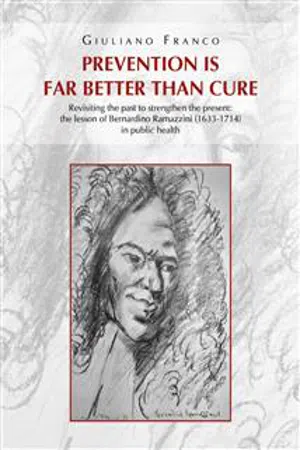
Prevention is far better than cure. Revisiting the past to strengthen the present: the lesson of Bernardino Ramazzini (1633-1714) in public health
- English
- ePUB (mobile friendly)
- Available on iOS & Android
Prevention is far better than cure. Revisiting the past to strengthen the present: the lesson of Bernardino Ramazzini (1633-1714) in public health
About this book
Doctor at the court and academic of the Modena and Padua Universities, Bernardino Ramazzini (1633-1714) lived in the second half of the seventeenth century. Without renouncing to his vocation as a doctor, he visited the craft workshops to identify the threats to health, examined the diseases of workers and proposed a variety of preventive measures. Aware of the need to avoid extremes of all kinds, he recommended moderation in all types of behaviour. The expression «prevention is far better than cure» summarises his precept. Through the description of the context in which he lived and the analysis of his observations and proposals, the essay explores Ramazzini's main works by revisiting his thinking in a contemporary way, highlighting the modernity of his anticipatory reflections and focusing on his visionary ideas.
Frequently asked questions
- Essential is ideal for learners and professionals who enjoy exploring a wide range of subjects. Access the Essential Library with 800,000+ trusted titles and best-sellers across business, personal growth, and the humanities. Includes unlimited reading time and Standard Read Aloud voice.
- Complete: Perfect for advanced learners and researchers needing full, unrestricted access. Unlock 1.4M+ books across hundreds of subjects, including academic and specialized titles. The Complete Plan also includes advanced features like Premium Read Aloud and Research Assistant.
Please note we cannot support devices running on iOS 13 and Android 7 or earlier. Learn more about using the app.
Information
Table of contents
- Preface
- Overview
- 1 - Introduction
- 2 - An all-around doctor and scientist
- 3 - The historical context
- 4 - Territory and demographic structure of the Duchy of Modena and Reggio
- 5 - Culture in Modena Capital
- 6 - Economy, techniques & technology of production in the seventeenth century
- 7 - Work and health:an epistemological relationship
- 8 - Work and health in Ramazzini’s thought
- 9 - Medicine and doctors in the second half of the seventeenth century
- 10 - The commitment to the health of peasants and artisans
- 11 - The Diatriba about workers’ diseases
- 12 - The Commentatio on princes’ disorders
- 13 - A semantic readingof the Diatriba
- 14 – Quam artem exerceas? What is your job?
- 15 - The epidemiological approach
- 16 - Residential proximityto environmental hazards:a paradigmatic case
- 17 - Health risks from exposureto metals
- 18 - Work-related lung disorders
- 19 - An eponymousof a work-related syndrome:the hypersensitivity pneumonitis
- 20 - Physical effort, poor posture and fatigue: the epidemicsof musculoskeletal disorders
- 21 - Stress on mind and body
- 22 - Health problems associated to nightwork and long hours of work
- 23 - Occupation and voice disorders
- 24 - Environmental noise and health
- 25 - Health problems from exposure to radiations, workplace heat and external climate
- 26 - Medications and risks to health
- 27 - Odours, headache, and hypersusceptibility
- 28 - Eye fatigue
- 29 - Work-related cancer
- 30 - Discovering the link between environmental hazard & risk to health
- 31 - Risk communication
- 32 - Old and new preventive approaches: hazard identification, risk assessment, and health protection measures
- 33 - Personal protective measures
- 34 - The theme of moderation in the Diatriba and the Commentatio
- 35 - Workers well-being and workplaces health promotion
- 36 - Sedentary job and physical activity
- 37 - Food intake
- 38 - Alcohol drinking
- 39 - Exposure to tobacco
- 40 - Inequalities and vulnerabilities: then and now
- 41 - Gender inequality and vulnerability
- 42 - Inequalities and vulnerabilities: ethnic minority workers
- 43 - Ethical issues in health protection of workers: a framework
- 44 - Principles and ethical virtues of the Diatriba
- 45 - First, do no harm and pursue the good
- 46 - An empathic attitude toward individual and people
- 47 - Serving the interest of the people and ignoring external pressures
- 48 - Love for study, willingness to improve, humanitarian attitude
- 49 - Fostering the integration of practical medicine (Medicina practica) and experimental research (Medicina theorica)
- 50 - Prevention is far better than cure
- 51 – On the development of risk prevention and workers health protection
- 52 - Occupational health & whole-person health
- 53 - The lesson of Ramazzini
- 54 - Afterwords. The legacy of the pioneering work of the Magister
- Biographical notes, relevant historical events and other facts
- Relevant quotations
- Bibliography - 1. Ramazzini’s works and writings
- Bibliography - 2. References
- Figures & Table